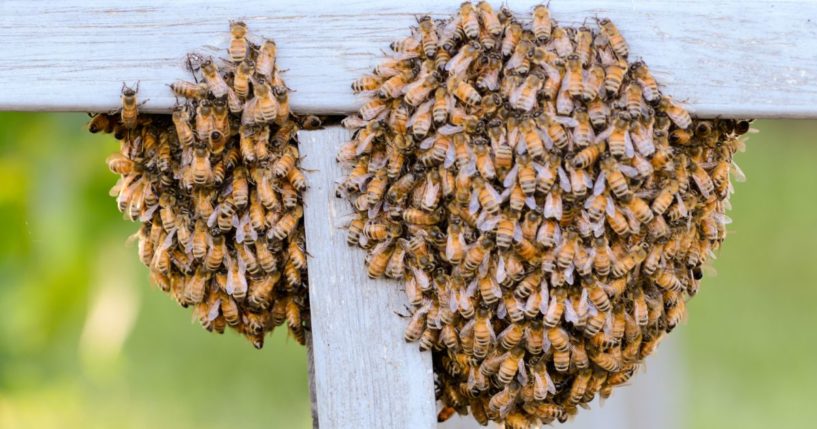
What Should I Do if I Find a Swarm of Bees?
If you have yet to encounter a swarm of bees, it’s best to know beforehand what to do in case you experience an initial feeling of panic.
First, what is a swarm of honeybees?
Honeybee colonies reproduce by swarming, a process where about one third to one half of the workers in a colony leave in a swarm with the queen to set up a hive in a new location. The original hive is left with a developing queen, worker bees, and brood.
A swarm of honeybees is typically composed of one queen and thousands of worker bees. Swarms can range from the size of a softball to larger than a basketball, depending on the number of bees.
A “bee invasion” halted play at the BNP Paribas Open tennis tournament in California on Thursday, and video showed the insects swarming over a camera lens and buzzing around players. https://t.co/MJM3hJEf6B
— NBC News (@NBCNews) March 15, 2024
Swarming can happen throughout the active beekeeping season (spring through fall) but is most common in Michigan in May and June.
When the colony determines conditions are right, the swarm leaves the hive. Before flying to its final destination, the swarm gathers close to the hive, often on a tree branch, fence post, or other nearby spot.
The swarm typically stays in this temporary location for a couple hours to several days, which is when it is often spotted by passers-by.
While the swarm is in this temporary location, scout bees search for a suitable location for the colony to take up more permanent residence. Once the new location is determined, the swarm departs and flies as a group to the new location.
Why should you contact a beekeeper if you find a swarm?
Because a swarm is a fully functioning colony, many beekeepers are prepared and willing to collect swarms into hive equipment to expand their beekeeping operations. Swarms that are not collected by beekeepers unfortunately may not survive.
Beekeepers have to manage honeybee colonies for parasites and disease, so unmanaged colonies have a high likelihood of dying due to unmanaged disease and parasite pressure. Even worse, as these unmanaged colonies die, they can risk spreading parasites and diseases to managed colonies.
The scouts of a honeybee swarm search for a cavity to establish a permanent hive, and while they sometimes find a tree cavity, it’s also possible they find a cavity in a building or structure. Colonies that establish within structures or near highly populated areas can be a nuisance or hazard.
It can be difficult and expensive to remove honeybee colonies from structures, so it’s good preventative practice to have a beekeeper capture the swarm before it has the chance to take up residence. It’s important for the sake of the honeybees and your neighbors to call a beekeeper if you see a swarm.
How can you find a beekeeper?
If you live in Michigan, the Michigan Beekeepers Association maintains a list of beekeepers who are interested in collecting swarms. For all other states, try searching for similar associations. You can also try reaching out to a local beekeeping club.
Note: Swarm removal is different from removing bees from houses or other structures. If the colony has already set up a hive in a building, you need a person who is willing to do a “cut out,” which you may find on the list of beekeepers who do building cut outs. You can read more about the difference on the problem and unwanted bees webpage.
Beekeepers who are interested in collecting swarms can find information on the Michigan Beekeepers Associations swarm removal webpage about how to be added to the list.
What information can you provide to the beekeeper about the swarm?
The beekeeper will want information about the swarm’s location. What is the address or GPS coordinates of the swarm? Is the swarm gathered on a tree branch, fence post or somewhere else?
How high off the ground is it? Is there anything surrounding the swarm that would make it difficult or dangerous to collect the swarm? Sometimes beekeepers travel long distances to collect swarms, so it is important to let them know if you have contacted other individuals or if the swarm flies away before they arrive.
Many people confuse honeybees with other insects like bumble bees, yellow jacket wasps, and paper wasps. The beekeeper may want to confirm that the insects are honeybees before traveling to collect the swarm.
Here are a couple of resources to help you figure out if you have a swarm of honeybees:
- “Insects that look like bees” from Michigan State University Extension
- Problem and unwanted bees webpage from Michigan Beekeepers Association
- “Bee, wasp or hornet nest: Which one is it?” from Michigan State University Extension
- “Getting rid of wasp nests” from Michigan State University Extension
If you can safely take photos from a distance, the photos may help the beekeeper determine if the insects are in fact honeybees. Photos can also help provide context about the swarm’s location.
If you find a swarm of bees, is it a sign that you should become a beekeeper?
Remember that honeybees are animals that require a lot of specialized care to thrive, so before you plan on keeping a swarm, consider if you have the time and resources to care for them.
If you find yourself fascinated by a swarm of honeybees and want to learn to keep bees, MSU Extension suggests you take a year to learn about beekeeping before you get started. You can start by taking MSU’s free online course, Is Beekeeping Right for Me?
If you think beekeeping is a good fit for you, you can find resources and educational opportunities on MSU’s webpage, “Getting started with beekeeping in Michigan.”
MSU suggests beekeepers join a local beekeeping club in Michigan, many of which hold regular meetings to provide educational information. You should review “Michigan Beekeeping Rules and Regulations” before getting started.
Where can I ask additional questions about honeybees and beekeeping?
You can submit questions about honeybees through the Michigan Beekeeping Ask Extension form.
This article appeared originally on Michigan State University Extension.
Truth and Accuracy
We are committed to truth and accuracy in all of our journalism. Read our editorial standards.
Advertise with The Western Journal and reach millions of highly engaged readers, while supporting our work. Advertise Today.












